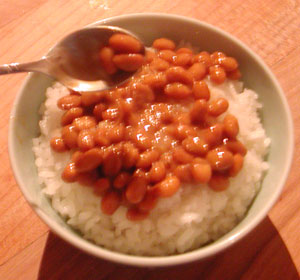
Japanese people like to consume soy beans in many forms. The most well known soy bean product outside of the country is tofu, and edamame (green soy beans) is gaining in popularity too. There is one Japanese soy bean product that probably will never become very popular in other countries though, and that's natto.
Filed under:
japanese ingredients natto legumes vegetarian vegan
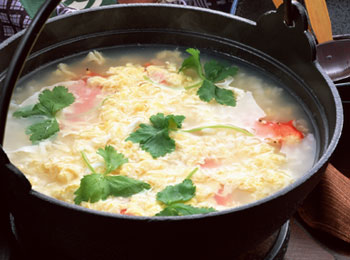
Continuing on the theme of temple food - simple, easy to digest food that is gentle on the stomach and the soul - here is zohsui, or ojiya. Where I grew up, we called it ojiya, which is considered a more vulgar term. Whatever you call it, it's essentially a soup made of rice, various aromatic vegetables, egg, and sometimes some seafood or chicken. It's closely related to Chinese congee.
Filed under:
japanese lighter soup rice
The term "teriyaki" is used a lot these days. Usually it indicates that a sweet-savory soy-sauce based sauce called teriyaki sauce has been used. However, teriyaki is actually the word for a cooking method - and it's very easy to do.
Filed under:
basics japanese chicken
Soy sauce is a basic ingredient in Japanese as well as many other Asian cuisines.
In Japan, there are basically four types of soy sauce: regular dark, light or usukuchi, reduced sodium or genen, and tamari, which are the rather syrupy dregs of soy sauce at the bottom of the barrel. The first two are the ones most commonly used for cooking. Reduced sodium is of course used by people with high blood pressure concerns. Tamari is never used for cooking - it's usually used as a dipping sauce, for sashimi and such.
Filed under:
japanese ingredients
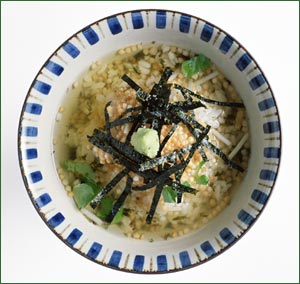
ochazuke is rice, tea and a lot of very Japanese stuff.
Ochazuke combines two quintessentially Japanese ingredients, plain white rice and green tea. Ochazuke is commonly served at the very end of an elaborate Japanese full course meal. It's also favored as a midnight snack, a hangover cure, or just when you want something hot and filling. It's commonly made with leftover rice, though ideally the rice should be heated up if it's cold.
Filed under:
japanese rice favorites tea
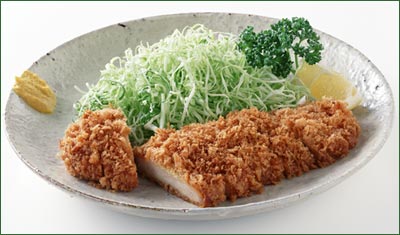
tonkatsu, breaded deep fried pork cutlets
Tonkatsu is a typical Japanglish word - ton is pig or pork, and katsu derives from the word cutlet. Tonkatsu is one of the western-style Japanese dishes that can be classified as yohshoku. However, tonkatsu is so popular in Japan that there are even restaurants that only serve tonkatsu and similar items such as kushikatsu (bite-sized fried bits of pork and other things on a skewer).
One of the key ingredients for tonkatsu, or any breaded deep-fried item in Japanese cooking, is panko. In recent years panko has been adopted by the trendy world of cuisine, but it's not anything special - it's just dried bread crumbs. The thing that makes panko unique is that the flakes are bigger and crunchier than the kind sold by non-Japanese food manufacturers.
You can buy panko ready-made at Japanese food stores, or make your own. To make your own, take off the crusts of day-old good white bread. Flake the white part of the bread by hand, not the food processor, which would turn the bread into powder. Spread out the bread crumbs on baking sheets and dry in the oven at a very low temperature until the crumbs are thoroughly try - not colored, just crunchy. You can store this in tightly sealed plastic bags or containers for quite a long time.
Filed under:
japanese yohshoku pork
So far I have been writing about Japanese foods that are quite traditional. The flavors are based on the SaShiSuSeSo of sugar, salt, rice vinegar, soy sauce and miso, plus the all-important dashi soup stock. In Japan, this kind of food is called washoku, or quite literally "Japanese food".
Filed under:
basics japanese yohshoku
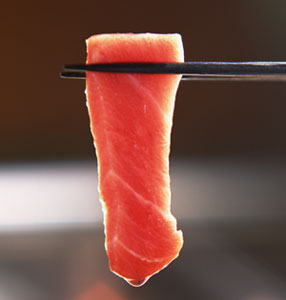
I wrote this article originally for the Sushisay New York web site. I've edited it a bit for this version.
Tane or dane is the stuff that goes on top of, or inside, sushi rice to make sushi. Sushi dane is very seasonal. Right now, tuna, probably the most popular sushi dane of all, is at its best.
Filed under:
japanese ingredients sushi fish
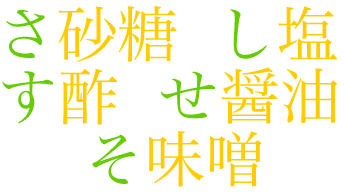
Top row: Sa (satoh=sugar), Shi (shio=salt); Middle row: Su (su=vinegar), Se (shoyu=soy sauce);
Bottom row: So (miso=fermented soy bean paste)
Besides dashi stock, the basic flavors of traditional Japanese cuisine are sugar, salt, soy vinegar, soy sauce and miso. While not many sauces uses all of these ingredients, many use at least 3.
Filed under:
basics japanese ingredients
(This is a revised and expanded version of a recipe that I posted when Just Hungry was brand new.)
Japanese people love eating eggs in many ways. One of the most popular uses for the egg is to make a very thin omelette called usuyaki tamago (literally, thinly cooked egg). Usuyaki tamago is used julienned as a garnish, or as a wrapper for sushi rice and other things.
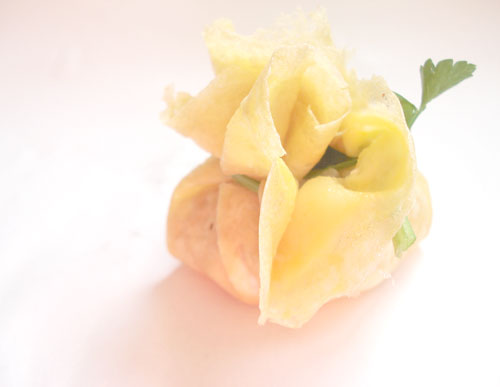
Filed under:
basics eggs japanese
Pages